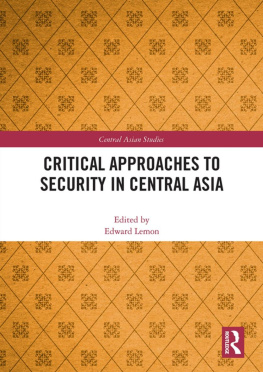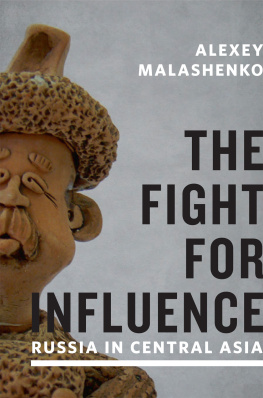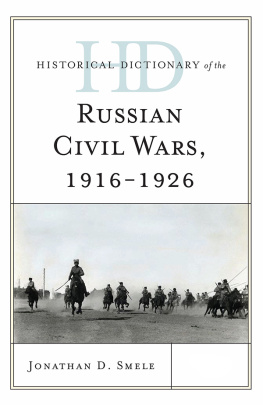Edward Dennis Sokol - The Revolt of 1916 in Russian Central Asia
Here you can read online Edward Dennis Sokol - The Revolt of 1916 in Russian Central Asia full text of the book (entire story) in english for free. Download pdf and epub, get meaning, cover and reviews about this ebook. City: Baltimore, year: 2016, publisher: Johns Hopkins University Press, genre: History. Description of the work, (preface) as well as reviews are available. Best literature library LitArk.com created for fans of good reading and offers a wide selection of genres:
Romance novel
Science fiction
Adventure
Detective
Science
History
Home and family
Prose
Art
Politics
Computer
Non-fiction
Religion
Business
Children
Humor
Choose a favorite category and find really read worthwhile books. Enjoy immersion in the world of imagination, feel the emotions of the characters or learn something new for yourself, make an fascinating discovery.

- Book:The Revolt of 1916 in Russian Central Asia
- Author:
- Publisher:Johns Hopkins University Press
- Genre:
- Year:2016
- City:Baltimore
- Rating:3 / 5
- Favourites:Add to favourites
- Your mark:
- 60
- 1
- 2
- 3
- 4
- 5
The Revolt of 1916 in Russian Central Asia: summary, description and annotation
We offer to read an annotation, description, summary or preface (depends on what the author of the book "The Revolt of 1916 in Russian Central Asia" wrote himself). If you haven't found the necessary information about the book — write in the comments, we will try to find it.
The Revolt of 1916 in Russian Central Asia — read online for free the complete book (whole text) full work
Below is the text of the book, divided by pages. System saving the place of the last page read, allows you to conveniently read the book "The Revolt of 1916 in Russian Central Asia" online for free, without having to search again every time where you left off. Put a bookmark, and you can go to the page where you finished reading at any time.
Font size:
Interval:
Bookmark:
The Revolt of 1916 in Russian Central Asia
Edward Dennis Sokol
With a Foreword by S. Frederick Starr

1954, 2016 Johns Hopkins University Press
All rights reserved. Published 2016
Printed in the United States of America on acid-free paper
9 8 7 6 5 4 3 2 1
Johns Hopkins University Press
2715 North Charles Street
Baltimore, Maryland 21218-4363
www.press.jhu.edu
Library of Congress Cataloging-in-Publication Data
Names: Sokol, Edward D., author.
Title: The revolt of 1916 in Russian Central Asia / Edward Dennis Sokol ; with a foreword by S. Frederick Starr.
Description: Baltimore, Maryland : Johns Hopkins University Press, 2016. | Originally published: 1954. | Includes bibliographical references and index.
Identifiers: LCCN 2015043854| ISBN 9781421420509 (pbk. : alk. paper) | ISBN 9781421420516 (electronic) | ISBN 1421420503 (pbk. : alk. paper) | ISBN 1421420511 (electronic)
Subjects: LCSH: Asia, CentralHistoryRevolt, 1916. | World War,
19141918Asia, Central. | GenocideAsia, CentralHistory20th century. Classification: LCC DK858 .S65 2016 | DDC 958.43/083dc23 LC record available at http://lccn.loc.gov/2015043854
A catalog record for this book is available from the British Library.
Special discounts are available for bulk purchases of this book. For more information, please contact Special Sales at 410-516-6936 or .
Johns Hopkins University Press uses environmentally friendly book materials, including recycled text paper that is composed of at least 30 percent post-consumer waste, whenever possible.
, by S. Frederick Starr
A century ago approximately 270,000 Central AsiansKazakhs, Tajiks, Turkmen, Uzbeks, and especially Kyrgyzperished in one of the most ghastly mass deaths in modern history. This horrific killing took place when Russian officials attempted to draft natives of the region to fight and provide labor service for the tsar during World War I. In addition to those killed outright, tens of thousands more died while trying to escape over treacherous mountain passes into neighboring Xinjiang, China. Even today, bones of victims of this disaster continue to wash out from the rocky bottoms of deep crevasses in the Tian Shan mountains.
The scale of this demographic disaster is hard to grasp. Recent experts calculate that the Kyrgyz, who suffered most heavily, lost fully 40% of their total population. All age groups suffered, but younger males died in disproportionate numbers, causing a demographic breakdown that is still felt today. It is estimated that had the tragedy of 1916 not occurred, the population of the Kyrgyz Republic would be twice what it is today.
Unlike the Armenian genocide, which was unfolding in Turkey at almost the same time, this mass killing of more than a quarter million people has been largely expunged from the worlds historical consciousness. There are good reasons for this. Even as the last phase of the 1916 Uprising was taking place in Turkmenistan, Lenin and his Bolsheviks were overthrowing the tsarist government in St. Petersburg and establishing Soviet rule. During the first years after the Bolshevik coup, informative articles on the events of 1916 appeared in Russia, but by the end of the 1920s these ceased. As Lenins heirs strove to establish the Soviet Union as a multinational empire, the tragic events of 1916 became a taboo subject. They disappeared from the history books, and the Central Asians themselves were forbidden to delve into them. With the exception of a couple of minor studies from the 1960s, the scholarly literature on the 1916 Uprising dates mainly from the 1990s, after the collapse of the USSR. But even today the Putin government bans access to the tsarist archives in Moscow, where records of the events leading up to 1916 and of the Uprising itself are housed.
The one exception to this general silence, and a very worthy one, appeared in 1954, when an enterprising young American scholar, Edward Dennis Sokol of Johns Hopkins University, published the short book that is here reissued. Sokol modestly considered his study to be a pioneering work rather than a definitive study, but his accomplishment was impressive by any standard. He exhaustively researched all published sources available at the time, and especially the documents and articles that were issued in such early Soviet periodicals as Krasnyi Arkhiv (The Red Archive). Moreover, he presented his findings in a calm and dispassionate manner that allows readers to draw their own conclusions.
The very structure of Sokols book reflects his realization that the 1916 Uprising was about more than the drafting of young Kyrgyz and other Central Asians to fight with the tsarist army in World War I or to staff Russias arms factories. By devoting nearly half of his study to the specific policies of Russian rule in Central Asia he implies that 1916 marked the culmination of several generations of steady Russian encroachment against the land and rights of the indigenous peoples and the product of the utter corruption that permeated Russian rule there. The 1916 Uprising, then, was a revolt against Russian colonialism in all its dimensionseconomic, political, religious, and nationaland not simply a draft riot. It is worth noting that this view is emphatically shared by the Kyrgyz scholar and diplomat Kuban Mambetaliev, who has recently published an important collection of papers on the Uprising drawn from archives within Kyrgyzstan.
The 1916 Uprising was region-wide in scope, but it assumed a different character in every part of Central Asia. Among the settled peoples of the Ferghana Valley of Uzbekistan, Tajikistan, and Kyrgyzstan (to whom Sokol refers with the old term Sarts) and on the Merv oasis in Turkmenistan, the focus was on the usurpation of cotton land by Russian settlers and the governments demand that local farmers turn over part of their crop to the state, in addition to paying taxes. They rightly understood that this form of corve labor was similar to serfdom that had been abolished in Russia. In mountain areas in Kyrgyzstan and East Kazakhstan the Turkic peoples objected to being forced to raise poppies to produce opium needed to treat wounded soldiers on the European front. Religious and national concerns also played a part, although Sokol cautions against overemphasizing these factors.
The common element among all these contributing factors was the relentless usurpation of native lands by Russian settlers and the Russian state and the deep corruption that accompanied it. This process had been going on since the Russians first appearance in Central Asia. It took the proposed draft and the requisition of ever more meat and cotton from Central Asia to drive the Turkic and Persianate populations into outright rebellion. Or did it? Sokol cites an extensive study by one G. I. Broido, who was a firsthand observer of the Uprising and who reported in detail on what he had seen. Written in September 1916, while the last phase of the Uprising was still under way, Broido acknowledged all the various background factors but then offered a stunning hypothesis, namely, that the tsars colonial bureaucrats and military leaders deliberately fomented the Uprising to justify the seizure of more land from the Kyrgyz, Kazakhs, Uzbeks, Turkmens, and Tajiks. It is worth noting that Broido was a member of the Bolshevik Party that would seize power in Petrograd a year later.
Broidos thesis has recently garnered support from Kuban Mambetaliev, editor of the newly published collection of documents cited above, who republished extracts from it.a hypothesis that must be carefully tested in each of the many regions in which the Uprising welled up. This will require detailed studies of the Uprising of 1916 in each of the countries of the region. Even though Russian officials have closed the main Moscow archives to scholars, there are relevant materials from the tsarist era in the archives in each of the countries of Central Asia, and especially those in Tashkent, Uzbekistan, and Almaty (formerly Vernyi), Kazakhstan. A careful examination of these sources will go far towards establishing whether Russian colonial administrators deliberately fomented the Uprising of 1916 in order to provide a pretext for seizing native lands.
Next pageFont size:
Interval:
Bookmark:
Similar books «The Revolt of 1916 in Russian Central Asia»
Look at similar books to The Revolt of 1916 in Russian Central Asia. We have selected literature similar in name and meaning in the hope of providing readers with more options to find new, interesting, not yet read works.
Discussion, reviews of the book The Revolt of 1916 in Russian Central Asia and just readers' own opinions. Leave your comments, write what you think about the work, its meaning or the main characters. Specify what exactly you liked and what you didn't like, and why you think so.






